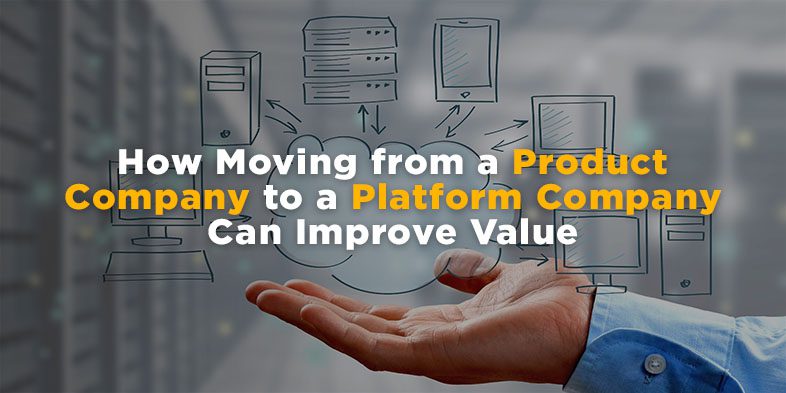How Moving from a Product Company to a Platform Company Can Improve Value


As part of Solutions Review’s Contributed Content Series—a collection of contributed articles written by our enterprise tech thought leader community—Mohan Madhurakavi, the Chief Evangelist of Digital Transformation at Kissflow, explains how (and why) companies can increase their value by shifting into a platform company mindset.
 In 2000, Amazon debuted Amazon Marketplace—officially shifting its core business model from a product company to a platform company. The former bookseller was in good company, too—by 2015, many of the world’s most valuable companies by market capitalization, including Apple, Microsoft, Google/Alphabet, Amazon, and Facebook/Meta, would also become platform companies.
In 2000, Amazon debuted Amazon Marketplace—officially shifting its core business model from a product company to a platform company. The former bookseller was in good company, too—by 2015, many of the world’s most valuable companies by market capitalization, including Apple, Microsoft, Google/Alphabet, Amazon, and Facebook/Meta, would also become platform companies.
But what does it take to transform from product to platform? Is the investment worth the return? Does becoming a platform company guarantee your valuation will skyrocket? If these questions pique your curiosity, stay with us as we explore the nuances and benefits of being a platform company and how you can make the shift.
The Platform Advantage
Platform companies boast a notably high Price-to-Book ratio, a metric that indicates the market’s valuation of a company relative to its book value. Amazon, for example, has a staggering (P/B) ratio of 25. This means a mere 4 percent of its assets are on the balance sheet, leaving a whopping 96 percent outside, invisible to traditional metrics. Its (P/B) ratio is astonishing compared to the total market average of 3.89. The same holds for other industry leaders like Alphabet, Meta, Netflix, and Apple.
But what are these unseen assets? Assets, in this context, are the ones that generate cash. The shift from product to platform signals a move from valuing tangible assets on balance sheets to recognizing the immense value in intangibles. The competition has evolved, too—it’s no longer between products; it’s a platform-to-platform battle.
To understand how these companies have transitioned, it’s important to define what being a platform company truly means. A platform lets others utilize its assets to generate profits. It relies on an ecosystem of customers, technology, and partners, creating value for each and often more than the original company. Altruism is a crucial pillar of this transformation—letting others complement your strengths, freeing you to focus on your core competencies.
Transforming Products into Platforms: It’s All in the Mindset
Evolving a product company into a platform company is often a matter of perspective. To grasp this, consider the evolution of iconic products into platforms and how altering perspectives can redefine entire industries.
Imagine Barbie not as a mere doll but as a comprehensive platform catering to the diverse tastes and preferences of children globally. Instead of competing solely with other dolls on the shelf, envision Barbie as a movie platform—one that we saw come to fruition in the Summer of 2023. This perspective involves global customization, strategic partnerships, and the creation of an entire lifestyle brand for kids. Picture Barbie not just as a toy but as the central figure in a world of movies, comics, events, and collaborative ventures. Replace Barbie with Superman or the Avengers; you get the same effect. This mindset shift transforms Barbie from a product to a dynamic platform, offering an immersive experience far beyond the confines of traditional doll competition.
The same could be said for a Honda engine in the industrial market. Rather than seeing it as a standalone product confined to specific applications (like powering Hondas alone), consider the transformative power of positioning it as a platform. When Honda allows others to integrate its engine into various applications—small lawnmowers, automobiles, or motorboards—it becomes a catalyst for innovation. This mindset shift unleashes the engine’s potential to drive solutions beyond Honda’s traditional scope.
In essence, the transformation from product to platform is not about changing the physical attributes of a doll or an engine; it’s about expanding their roles, creating ecosystems, and fostering collaborations that transcend the conventional boundaries of competition. Once you’ve homed in on your core value, you can shift your strategic focus and embrace a dynamic model that invites others to build upon, innovate, and contribute to a broader, interconnected landscape.
Identifying and Leveraging Assets
The journey from a product-centric model to a platform-driven approach demands a keen understanding of assets within and outside your company. To make this change, understand these four things first—this will narrow the focus of your transformation strategy:
Customer Intimacy
If your customers trust and value your product, you can leverage your brand reputation outside your traditional expertise. High customer regard opens doors for collaborations in various domains.
Data
Data is a goldmine. If you have detailed customer behavior data, especially in real-time, other companies might be willing to pay a premium for it.
Partnerships
Leverage existing partnerships—be it logistics, technology, or cross-border collaborations. Your network of partners can be a significant platform asset.
Superior Design
Identify your unique strengths, whether in design, patents, or processes. If design is your forte, explore avenues like 3D printing and sell soft copies of your designs.
Digital Transformation and Platforms: The Indispensable Connection
When moving from a product model to a platform model, don’t dismiss digital transformation as a buzzword only. Instead, understand that it is a powerful tool to fuel agility, innovation, and seamless integration. Such agility is made possible through technologies like low-code/no-code that allow business users to take advantage of their organization’s democratized data. These tools empower teams to adapt, innovate, and swiftly respond to evolving market demands. The dynamic nature of platforms requires an agile foundation, and embracing digital transformation becomes the catalyst for sustained success.
The transformation from a product-centric entity to a thriving platform company isn’t just a shift in strategy; it’s a mindset, a recognition of assets, and a commitment to digital evolution.



















